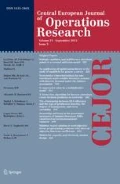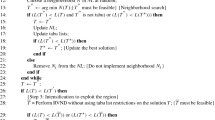Abstract
The traveling delivery person problem (TDP) is a customer-oriented modification of the traveling salesperson problem, which minimizes the sum of delivery times at clients’ destinations. Besides the classical applications in routing or emergency logistics, it recently arises in other research areas as mission planning in mobile robotics, where the goal is to search a known or unknown environment efficiently. Such an original deployment may require solving a series of instances in a periodical manner with a fixed period in order of units or tens of seconds—a scenario seldom considered in the literature when designing and evaluating a solution method for the problem. This paper addresses the difficulty of evaluating stochastic improving algorithms in less traditional applications such as the one aforementioned. A new metaheuristic for the TDP is designed using a general run-time distribution methodology and time-to-target plots. Evaluated on several sets of benchmark instances, it significantly outperforms the current best approach from the literature under the hard time limit settings with limits ranging from 1 to 100 seconds. Still, as shown on a subset of the instances, it provides competitive results in the traditional sense and with cost targets corresponding to the best-known solutions worsened by about 1%. Lastly, four new best-known solutions of 500-customer instances found by the proposed method are reported.





Similar content being viewed by others
Availability of data and material
Not applicable.
Code Availability Statement
The code is available at http://imr.ciirc.cvut.cz/Downloads/Software.
References
Abeledo H, Fukasawa R, Pessoa A, Uchoa E (2010) The time dependent traveling salesman problem: Polyhedra and branch-cut-and-price algorithm. In: Festa P (ed) Experimental algorithms. Springer, Berlin, pp 202–213
Abeledo H, Fukasawa R, Pessoa A, Uchoa E (2013) The time dependent traveling salesman problem: polyhedra and algorithm. Math Program Comput 5(1):27–55
Aiex RM, Resende MG, Ribeiro CC (2002) Probability distribution of solution time in GRASP: an experimental investigation. J Heuristics 8(3):343–373
Archer A, Blasiak A (2010) Improved approximation algorithms for the minimum latency problem via prize-collecting strolls. In: Proceedings of the Twenty-First Annual ACM-SIAM Symposium on Discrete Algorithms, Society for Industrial and Applied Mathematics, Philadelphia, PA, pp 429–447
Archer A, Williamson DP (2003) Faster approximation algorithms for the minimum latency problem. In: Proceedings of the Annual ACM-SIAM Symposium on Discrete Algorithms, SIAM, pp 88–96
Archer A, Levin A, Williamson DP (2008) A faster, better approximation algorithm for the minimum latency problem. SIAM J Comput 37(5):1472–1498
Ausiello G, Leonardi S, Marchetti-Spaccamela A (2000) On Salesmen, Repairmen, Spiders, and Other Traveling Agents. In: Lecture Notes in Computer Science (including subseries Lecture Notes in Artificial Intelligence and Lecture Notes in Bioinformatics), pp 1–16
Ban HB, Nguyen K, Ngo MC, Nguyen DN (2013) An efficient exact algorithm for the Minimum Latency Problem. Progress Inf 10:167
Bianco L, Mingozzi A, Ricciardelli S (1993) The traveling salesman problem with cumulative costs. Networks 23(2):81–91
Blum A, Chalasani P, Coppersmith D, Pulleyblank B, Raghavan P, Sudan M (1994) The minimum latency problem. In: Proceedings of the twenty-sixth annual ACM symposium on Theory of computing - STOC ’94, ACM Press, New York, New York, USA, pp 163–171
Bulhões T, Sadykov R, Uchoa E (2018) A branch-and-price algorithm for the Minimum Latency Problem. Comput Oper Res 93:66–78
Campbell AM, Vandenbussche D, Hermann W (2008) Routing for relief efforts. Transp Sci 42(2):127–145
Ceallaigh DO, Ruml W (2015) Metareasoning for Concurrent Planning and Execution. In: Proceedings of the Symposium on Combinatoral Search
Chaudhuri K, Godfrey B, Rao S, Talwar K (2003) Paths, trees, and minimum latency tours. In: 44th Annual IEEE Symposium on Foundations of Computer Science, 2003. Proceedings., IEEE Computer. Soc, pp 36–45
Cook WJ (2012) In pursuit of the traveling salesman: mathematics at the limits of computation. Princeton University Press, Princeton Princeton
Faigl J, Hollinger GA (2014) Unifying multi-goal path planning for autonomous data collection. In: 2014 IEEE/RSJ International Conference on Intelligent Robots and Systems, IEEE, pp 2937–2942
Fakcharoenphol J, Harrelson C, Rao S (2007) The k -traveling repairmen problem. ACM Transactions on Algorithms 3(4):40–es
Feo TA, Resende MGC (1989) A probabilistic heuristic for a computationally difficult set covering problem. Oper Res Lett 8(2):67–71
Feo TA, Resende MGC, Smith SH (1994) A greedy randomized adaptive search procedure for maximum independent set. Oper Res 42(5):860–878
Fischetti M, Laporte G, Martello S (1993) The delivery man problem and cumulative matroids. Oper Res 41(6):1055–1064
Frederickson GN, Wittman B (2012) Approximation algorithms for the traveling repairman and speeding deliveryman problems. Algorithmica 62(3–4):1198–1221
Gentilini I, Margot F, Shimada K (2013) The travelling salesman problem with neighbourhoods: MINLP solution. Optim Methods Softw 28(2):364–378
Godinho MT, Gouveia L, Pesneau P (2014) Natural and extended formulations for the time-dependent traveling salesman problem. Discrete Appl Math 164:138–153
Gouveia L, Voß S (1995) A classification of formulations for the (time-dependent) traveling salesman problem. Eur J Oper Res 83(1):69–82
Gunawan A, Lau HC, Vansteenwegen P (2016) Orienteering problem: a survey of recent variants, solution approaches and applications. Eur J Oper Res 255(2):315–332
Hart JP, Shogan AW (1987) Semi-greedy heuristics: an empirical study. Oper Res Lett 6(3):107–114
Hoos HH, Stützle T (1998) Evaluating Las Vegas Algorithms—Pitfalls and Remedies. Proceedings of the Fourteenth Conference on Uncertainty in Artificial Intelligence pp 238–245, 1301.7383
Kulich M, Přeučil L, Miranda-Bront JJ (2014) Single robot search for a stationary object in an unknown environment. In: 2014 IEEE International Conference on Robotics and Automation (ICRA), IEEE, pp 5830–5835
Kulich M, Miranda-Bront JJ, Přeučil L (2017) A meta-heuristic based goal-selection strategy for mobile robot search in an unknown environment. Comput Oper Res 84:178–187
Lucena A (1990) Time-dependent traveling salesman problem—the deliveryman case. Networks 20(6):753–763
Martin O, Otto SW, Felten EW (1991) Large-step Markov chains for the traveling salesman problem. Complex Syst 5:219–224
Méndez-Díaz I, Zabala P, Lucena A (2008) A new formulation for the Traveling Deliveryman Problem. Discrete Appl Math 156(17):3223–3237
Mikula J (2021) Search for a static object in a known environment. Master’s thesis, Czech Technical University in Prague, Faculty of Electrical Engineering
Miranda-Bront JJ, Méndez-Díaz I, Zabala P (2014) Facets and valid inequalities for the time-dependent travelling salesman problem. Eur J Oper Res 236(3):891–902
Mjirda A, Todosijević R, Hanafi S, Hansen P, Mladenović N (2017) Sequential variable neighborhood descent variants: an empirical study on the traveling salesman problem. International Transactions in Operational Research
Mladenović N, Hansen P (1997) Variable neighborhood search. Comput Oper Res 24(11):1097–1100
Mladenović N, Urošević D, Hanafi S (2013) Variable neighborhood search for the travelling deliveryman problem. 4OR 11(1):57–73
Naeni LM, Salehipour A (2019) A New Mathematical Model for the Traveling Repairman Problem. In: 2019 IEEE International Conference on Industrial Engineering and Engineering Management (IEEM), IEEE, pp 1384–1387
Reinelt G (1991) TSPLIB—a traveling salesman problem library. ORSA J Comput 3(4):376–384
Resende MGC, Ribeiro CC (2016) Optimization by GRASP. Springer, New York
Ribeiro CC, Rosseti I (2015) tttplots-compare: a perl program to compare time-to-target plots or general runtime distributions of randomized algorithms. Optim Lett 9(3):601–614
Ribeiro CC, Rosseti I, Vallejos R (2009) On the use of run time distributions to evaluate and compare stochastic local search algorithms. In: Lecture Notes in Computer Science (including subseries Lecture Notes in Artificial Intelligence and Lecture Notes in Bioinformatics)
Rios EFS (2016) Exploração de estratégias de busca local em ambientes cpu/gpu. PhD thesis, Universidade Federal Fluminense
Roberti R, Mingozzi A (2014) Dynamic ng-path relaxation for the delivery man problem. Transp Sci 48(3):413–424
Sahni S, Gonzalez T (1976) P-Complete approximation problems. J ACM (JACM) 23(3):555–565
Salehipour A, Sörensen K, Goos P, Bräysy O (2011) Efficient GRASP+VND and GRASP+VNS metaheuristics for the traveling repairman problem. 4OR 9:189–209
Santana Í, Plastino A, Rosseti I (2020) Improving a state-of-the-art heuristic for the minimum latency problem with data mining. International Transactions in Operational Research 00:itor.12774,
Sarmiento A, Murrieta-Cid R, Hutchinson S (2004) A multi-robot strategy for rapidly searching a polygonal environment. In: Lecture Notes in Artificial Intelligence (Subseries of Lecture Notes in Computer Science) vol3315, pp 484–493
Satyananda D, Wahyuningsih S (2019) Sequential order vs random order in operators of variable neighborhood descent method. Telkomnika (Telecommunication Computing Electronics and Control) 17(2):801–808
Silva MM, Subramanian A, Vidal T, Ochi LS (2012) A simple and effective metaheuristic for the Minimum Latency Problem. Eur J Oper Res 221(3):513–520
Smith SL, Imeson F (2017) GLNS: an effective large neighborhood search heuristic for the generalized traveling salesman problem. Comput Oper Res 87:1–19
Acknowledgements
The authors thank Marcos Silva, who kindly provided us with his code and datasets.
Funding
This work was supported by the European Regional Development Fund under the project Robotics for Industry 4.0 (reg. no. CZ.02.1.01/0.0/0.0/15 003/0000470) and by the Grant Agency of the Czech Technical University in Prague, grant no. SGS21/185/OHK3/3T/37.
Author information
Authors and Affiliations
Corresponding author
Ethics declarations
Conflict of interest
The authors declare no conflicts of interest.
Additional information
Publisher's Note
Springer Nature remains neutral with regard to jurisdictional claims in published maps and institutional affiliations.
Rights and permissions
About this article
Cite this article
Mikula, J., Kulich, M. Solving the traveling delivery person problem with limited computational time. Cent Eur J Oper Res 30, 1451–1481 (2022). https://doi.org/10.1007/s10100-021-00793-y
Accepted:
Published:
Issue Date:
DOI: https://doi.org/10.1007/s10100-021-00793-y




